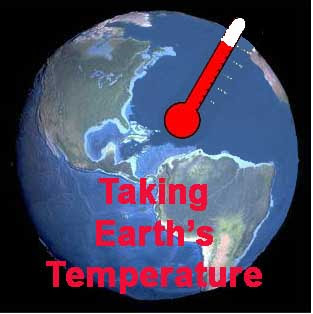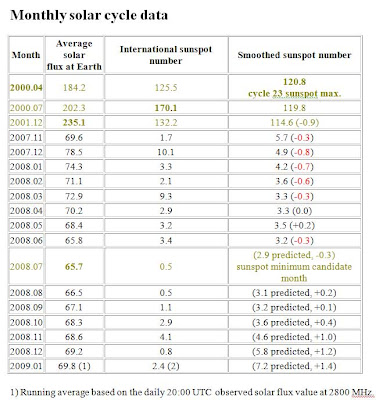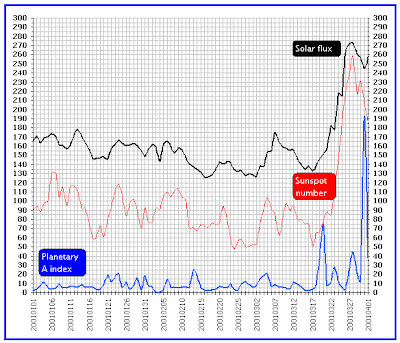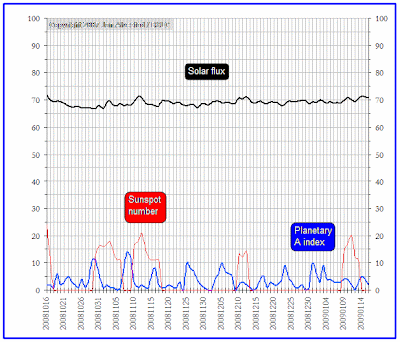 The evidence is pouring in discrediting anthropogenic global warming. Throughout recorded history, global temperatures and Sunspot activity form a positive link to each other. As you can see by the following chart, for the last two years, Sunspot activity has been very low. Recent data indicates that the Sunspot activity is remaining low instead of resuming the normal activity that is normally observed. -continued below--
The evidence is pouring in discrediting anthropogenic global warming. Throughout recorded history, global temperatures and Sunspot activity form a positive link to each other. As you can see by the following chart, for the last two years, Sunspot activity has been very low. Recent data indicates that the Sunspot activity is remaining low instead of resuming the normal activity that is normally observed. -continued below--
Compliments of http://www.solen.info/solar/
2001 Sunspot chart.

Compliments of http://www.solen.info/solar/ You can find historical data on Solar Cycles at this website.
Compare the above chart from 2001 to the chart below from the present.
2008-2009 Sunspot chart.

Sunspots are magnetic storms that heavily influence the weather on Earth. One theory claims that Sunspots inhibit cloud formation by interfering with cosmic radiation. Since clouds act as the world's umbrellas and reflect a lot of the Suns energy back into space, clouds act as a moderator for the world's temperatures. Fewer clouds mean warmer temperatures.
Cooling the Earth is as much a task as warming it because the Earth contains a buffer that resists the attempts to rapidly change the climate here on Earth; our oceans. Before temperatures can rise drastically on Earth, Ocean temperatures must rise. Conversely, to cool the Earth, the Oceans have to cool. The oceans are so vast that temperature changes are not rapid.
Recently, the warm oceans were able to reduce the Arctic ice to levels not seen since records have been kept. But in the last months of solar cycle 23, an event took place that changed the Sunspot activity. This event is called the 'Solar Jerk'. The recent 'Solar Jerk' in 2005 caused by the alignment of the planets reassigned the center of mass of the Sun known as the Baryscenter of the Solar System. The importance of this realignment cannot be understated. The 'Solar Jerk' affected the magnetic activity of the Sun decreasing the Sunspots which influence the Earth's climate.
The temperature of the world's oceans had been increasing with temperature reaching their maximum in 2007. However, recently, ocean temperatures have been decreasing. As the Oceans slowly surrender their heat, the process prevents us from abrupt changes in global temperature. But if the magnetic activity stays low on the Sun, we may be looking at severe winters as the world's oceans cool.
The following graph will show the gradual effect of the cooling oceans on the Arctic ice cap.

The dotted line represents the 2007 Arctic ice as measured in millions of square kilometers. Notice the blue line for 2008-2009. There has been a recovery in the icecap and if the current trend continues, it will surpass the average for the period between 1979-2000.
You can readily see that the icecap for 2008-2009 did not melt as much as it did in 2007. As the oceans cool, the icecap will continue to increase -- as long as the Sunspot activity stays low. Subsequent years will mean harsher winters as the oceans cool. This winter will be bad but consider it mild in comparison of what is to come if this trend continues.
The idea that man is causing the planet to warm is patently ridiculous. There are numerous reasons why CO2 is not causing the planet to warm. Blaming CO2 for global climate change is a political exercise. Fossil fuels do pollute and need cleaning. But fossil fuels are getting a bum rap with global warming.
Cheers,
-Robert-
No comments:
Post a Comment
Please Include First Name and Town. -Thanks-